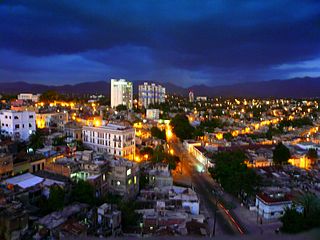
Santiago de Cuba is the second-largest city in Cuba and the capital city of Santiago de Cuba Province. It lies in the southeastern area of the island, some 870 km (540 mi) southeast of the Cuban capital of Havana.
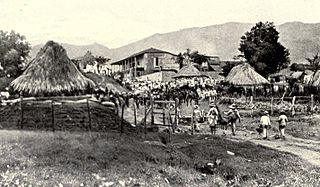
El Caney is a small village six kilometers to the northeast of Santiago, Cuba. "Caney" means longhouse in Taíno.

The Battle of Santiago de Cuba was a decisive naval engagement that occurred on July 3, 1898 between an American fleet, led by William T. Sampson and Winfield Scott Schley, against a Spanish fleet led by Pascual Cervera y Topete, which occurred during the Spanish–American War. The significantly more powerful US Navy squadron, consisting of four battleships and two armored cruisers, decisively defeated an outgunned squadron of the Royal Spanish Navy, consisting of four armored cruisers and two destroyers. All of the Spanish ships were sunk for no American loss. The crushing defeat sealed the American victory in the Cuban theater of the war, ensuring the independence of Cuba from Spanish rule.
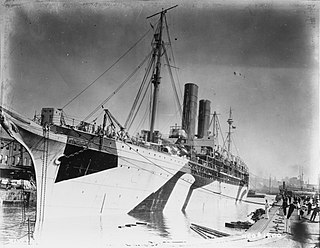
The first USS Harvard of the United States Navy was an auxiliary cruiser in the Spanish–American War. She was launched as City of New York, and later commissioned as Plattsburg (SP-1645) for service in World War I.

USS Siboney was a Commencement Bay-class escort carrier of the United States Navy. The Commencement Bay class were built during World War II, and were an improvement over the earlier Sangamon class, which were converted from oil tankers. They were capable of carrying an air group of 33 planes and were armed with an anti-aircraft battery of 5 in (127 mm), 40 mm (1.6 in), and 20 mm (0.8 in) guns. The ships were capable of a top speed of 19 knots, and due to their origin as tankers, had extensive fuel storage.
Two ships of the United States Navy have been named USS Siboney, after the town of Siboney, Cuba, the site of American landings in the Spanish–American War.
The fifth USS Eagle served in the United States Navy from 1898 to 1919, and saw action in the Spanish–American War and service during World War I.

Baracoa, whose full original name is: Nuestra Señora de la Asunción de Baracoa, is a municipality and city in Guantánamo Province near the eastern tip of Cuba. It was visited by Admiral Christopher Columbus on November 27, 1492, and then founded by the first governor of Cuba, the Spanish conquistador Diego Velázquez de Cuéllar on August 15, 1511. It is the oldest Spanish settlement in Cuba and was its first capital.

The Battle of Las Guasimas of June 24, 1898 was a Spanish rearguard action by Major General Antero Rubín against advancing columns led by Major General "Fighting Joe" Wheeler and the first land engagement of the Spanish–American War. The battle unfolded from Wheeler's attempt to storm Spanish positions at Las Guasimas de Sevilla, in the jungles surrounding Santiago de Cuba, with the 1st U.S. Volunteer Cavalry and the 10th Regular Cavalry.
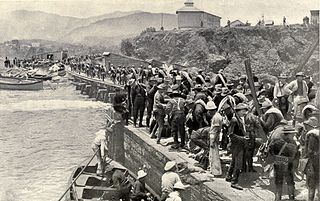
Daiquirí is a small village, 14 miles east of Santiago de Cuba. It became a focal point of the United States invasion of Cuba in the Spanish–American War.

Demetrio Castillo Duany was a Cuban revolutionary, soldier, and politician. He fought in the Cuban Independence and Spanish–American wars.

The Cuban War of Independence, also known in Cuba as the Necessary War, fought from 1895 to 1898, was the last of three liberation wars that Cuba fought against Spain, the other two being the Ten Years' War (1868–1878) and the Little War (1879–1880). The final three months of the conflict escalated to become the Spanish–American War, with United States forces being deployed in Cuba, Puerto Rico, and the Philippine Islands against Spain. Historians disagree as to the extent that United States officials were motivated to intervene for humanitarian reasons but agree that yellow journalism exaggerated atrocities attributed to Spanish forces against Cuban civilians.

Playa is a Cuban municipality, located in the Havana province. It covers an area of 36.8 square kilometers, which makes up 8.95% of the provincial extension.

The Battle of the Aguadores was a sharp skirmish on the banks of the Aguadores River near Santiago de Cuba, on 1 July 1898, at the height of the Spanish–American War. The American attack was intended as a feint to draw Spanish defenders away from their nearby positions at San Juan Hill and El Caney, where the main blows fell later that day.

The timeline of events of the Spanish–American War covers major events leading up to, during, and concluding the Spanish–American War, a ten-week conflict in 1898 between Spain and the United States of America.
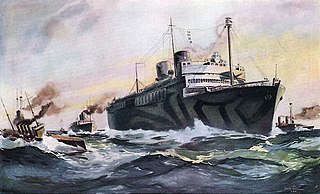
USS Siboney (ID-2999) was a United States Navy troopship in World War I. She was the sister ship of USS Orizaba (ID-1536). Launched as SS Oriente, she was soon renamed after Siboney, Cuba, a landing site of United States forces during the Spanish–American War. After her navy service ended, she was SS Siboney for the New York & Cuba Mail Steamship Co.. The ship was operated under charter by American Export Lines beginning in late 1940. During World War II she served the U.S. Army as transport USAT Siboney and as hospital ship USAHS Charles A. Stafford.

Manicaragua is a municipality and mountain town in the Villa Clara Province of Cuba. It is located in the Escambray Mountains at the southern part of Villa Clara, bordering the provinces of Cienfuegos to the west and Sancti Spíritus to the east.
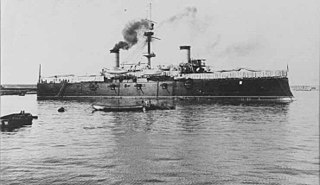
Cristóbal Colón was a Giuseppe Garibaldi-class armored cruiser of the Spanish Navy that fought at the Battle of Santiago de Cuba during the Spanish–American War.

The 146th Infantry Regiment was an infantry regiment of the United States Army, Ohio National Guard. It was formed in 1917 from the old 8th Ohio Infantry Regiment and served in several American wars from 1898 to 1919.
The 2nd Massachusetts Volunteer Infantry Regiment was an infantry unit of the United States Army, mustered into Federal service during the Spanish–American War.



















